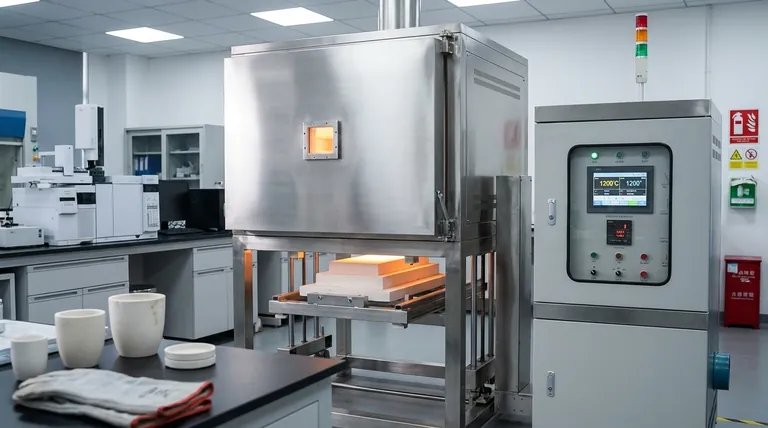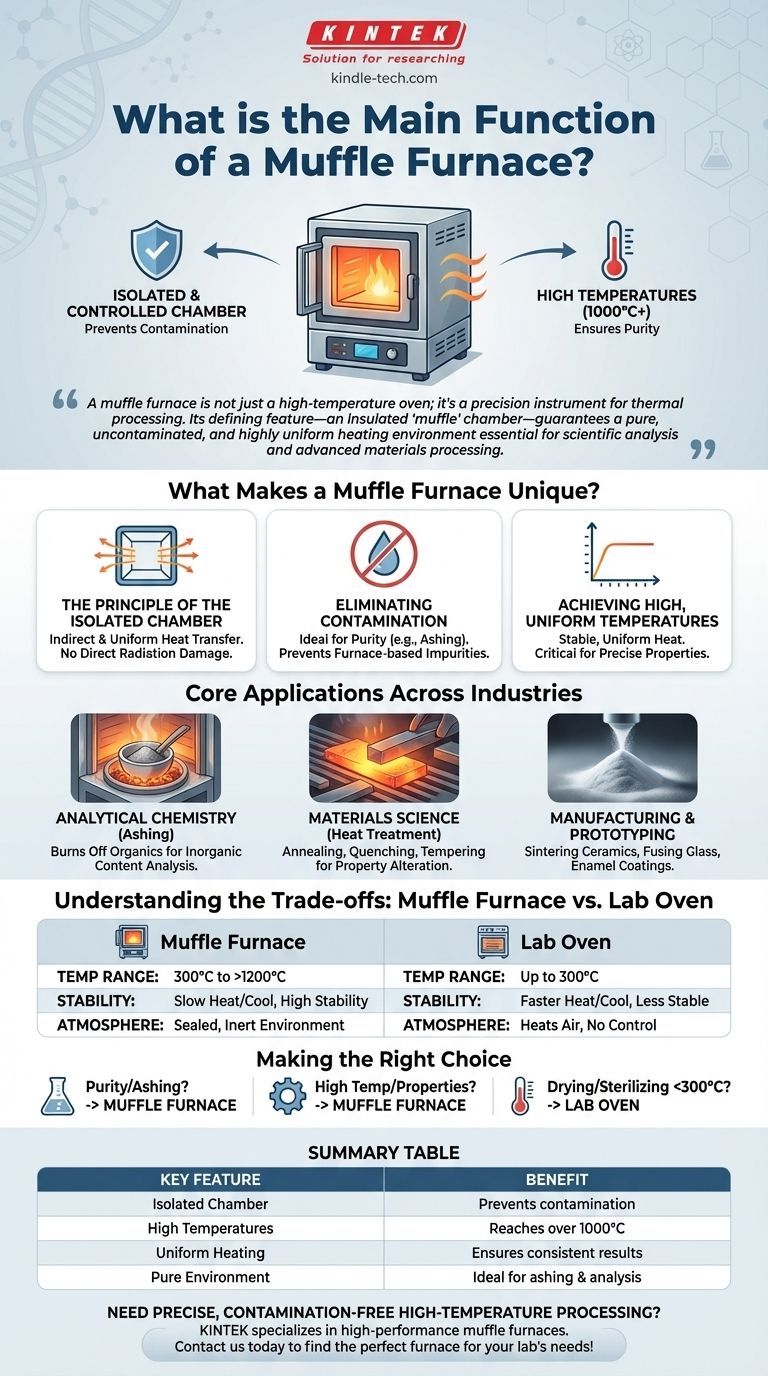The primary function of a muffle furnace is to heat materials to very high temperatures within a completely isolated and controlled chamber. This design prevents the sample from being contaminated by the heat source or any by-products of combustion, ensuring the material’s purity is maintained throughout the process.
A muffle furnace is not just a high-temperature oven; it's a precision instrument for thermal processing. Its defining feature—an insulated "muffle" chamber—guarantees a pure, uncontaminated, and highly uniform heating environment essential for scientific analysis and advanced materials processing.

What Makes a Muffle Furnace Unique?
The key to understanding a muffle furnace is its name. The "muffle" refers to the insulated inner chamber that separates the material being heated from the heating elements. This fundamental design principle delivers several critical advantages.
The Principle of the Isolated Chamber
A muffle furnace creates a chamber that is sealed from the heating elements themselves. This ensures that heat is transferred indirectly and uniformly to the sample.
Modern electric furnaces don't have combustion by-products, but the principle of isolation still prevents direct radiation damage and ensures exceptional temperature uniformity across the sample.
Eliminating Contamination
The isolated chamber is the furnace's most important feature. It makes the furnace ideal for processes where chemical purity is non-negotiable.
Applications like ashing require burning away organic material to measure the remaining inorganic content. Any contamination from the furnace itself would render the results inaccurate.
Achieving High, Uniform Temperatures
The heavy insulation and controlled environment allow muffle furnaces to reach very high temperatures, often exceeding 1000°C (1832°F).
More importantly, the temperature within the chamber is extremely stable and uniform, which is critical for heat-treating metals or sintering ceramics where precise temperature profiles dictate the final properties of the material.
Core Applications Across Industries
The unique capabilities of a muffle furnace make it an indispensable tool in research, development, and quality control.
Analytical Chemistry (Ashing)
The most common laboratory use is for ashing. A sample (like food, soil, or plastic) is heated to a temperature that completely burns off all organic compounds.
The remaining inorganic ash can then be weighed and analyzed to determine its composition, such as the mineral content in a food product.
Materials Science (Heat Treatment)
Muffle furnaces are central to metallurgy and materials science for altering the physical properties of materials.
Processes like annealing (softening metals), quenching (hardening them), and tempering (reducing brittleness) all require the precise temperature control that a muffle furnace provides.
Manufacturing and Prototyping
In manufacturing, these furnaces are used for creating new materials and components.
This includes sintering (fusing powdered materials like ceramics into a solid piece), fusing glass, and applying enamel coatings to metal surfaces.
Understanding the Trade-offs: Muffle Furnace vs. Lab Oven
Choosing the right heating instrument depends entirely on the required temperature and level of control.
Temperature Range
This is the most significant difference. A standard laboratory oven typically operates up to 300°C (572°F), while a muffle furnace is designed for applications from 300°C to over 1200°C.
Heating Rate and Stability
Due to their robust insulation, muffle furnaces heat up and cool down much more slowly than lab ovens. However, once at the target temperature, they offer far superior stability and uniformity.
Atmospheric Control
A standard oven simply heats the air inside. A muffle furnace provides a sealed, inert environment that protects the sample from oxidation and contamination, which is impossible in a basic oven.
Making the Right Choice for Your Goal
Selecting the correct thermal instrument is critical for achieving valid and repeatable results.
- If your primary focus is sample purity and quantitative analysis (like ashing): A muffle furnace is essential to prevent contamination and ensure accurate measurements.
- If your primary focus is altering material properties at high temperatures (like heat-treating metals or sintering ceramics): The superior temperature stability and uniformity of a muffle furnace are required.
- If your primary focus is simple drying, sterilizing, or heating below 300°C without strict atmospheric control: A standard laboratory oven is the more efficient and cost-effective choice.
Understanding the principle of the isolated chamber allows you to leverage the muffle furnace as a tool for precision, not just for heat.
Summary Table:
| Key Feature | Benefit |
|---|---|
| Isolated Chamber | Prevents sample contamination from heating elements |
| High Temperatures | Reaches over 1000°C for demanding processes |
| Uniform Heating | Ensures consistent results across the sample |
| Pure Environment | Ideal for ashing and material property analysis |
Need precise, contamination-free high-temperature processing? KINTEK specializes in laboratory equipment, including high-performance muffle furnaces designed for applications like ashing, heat treatment, and sintering. Our solutions ensure the accuracy and purity your research or quality control demands. Contact us today to find the perfect furnace for your lab's needs!
Visual Guide

Related Products
- Laboratory Muffle Oven Furnace Bottom Lifting Muffle Furnace
- 1400℃ Muffle Oven Furnace for Laboratory
- 1700℃ Muffle Oven Furnace for Laboratory
- 1800℃ Muffle Oven Furnace for Laboratory
- 1400℃ Laboratory Quartz Tube Furnace with Alumina Tube Tubular Furnace
People Also Ask
- At what temperature is it safe to open a muffle furnace? A Guide to Preventing Injury and Equipment Damage
- Does melting point ever change? Unlock the Secrets of Pressure and Purity
- What affects the melting point of a substance? Uncover the Key Factors & Forces
- What hazard is involved when using a furnace? Protect Your Home from the Silent Killer
- What is the temperature limit on a muffle furnace? A Guide to Selecting the Right Model



















